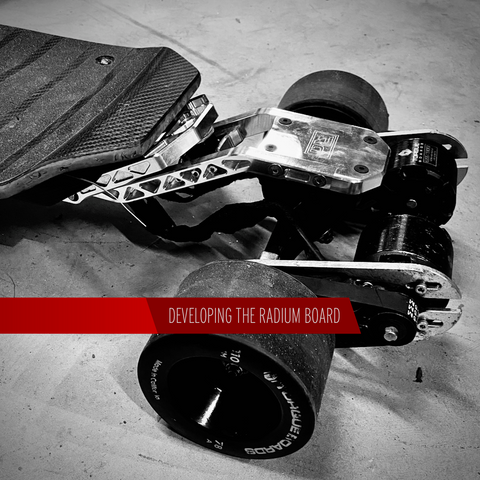We always wonder how other skate brands started out.
Its normally not well documented, so we decided to share our journey in a ground up, hands on development of a production electric skateboard.
Come on a ride with us and learn what it takes to be different.
Why create our own board?
In our opinion most electric skateboards currently on the market are based on more than 20 year old longboard technology, basically things that were never designed for the demands of high performance e-skating.
We often see other brands copying each others copies of traditional longboard tech with largely cosmetic treatments and only minimal technical improvements, leaving most of the industry sadly behind the times.
Why do we care? The answer is actually very humble – we're just addicted to the free feeling, adrenaline-on-tap, anti-depressant machine that a high-performance electric skateboard can be. We want to maximise that high as much as possible, milk it for all it's worth. We’ll go to great lengths to achieve it, as you’ll see in this blog series.
The Brief
Our road to a high performance, next level e-board is as follows:
Essentially we wanted to create a platform which could be highly customised to suit each individual rider. Choose your battery, deck, motor size, ride stiffness, truck width, thane or pneumatic wheels.
Go from a lightweight shop run board to a long-range missile. Carve like a surf skate or break the sound barrier. One board to do it all.

Flexible or rigid deck?
The first problem with motorising a skateboard is staying attached to it while riding. At speed a very stiff deck quickly becomes uncomfortable with repeated flexing over bumps and other obstacles. Some amount of flex is necessary.
However there is a common trait with decks that are flexible, and that is they don’t have much drop, concave or W. Which is a problem since you need those to feel locked in when moving fast.
Once you start adding shape to a flat surface it loses its ability to flex, hence steel roofs being corrugated to stop flex. A flexible deck also has the issue of requiring a flexible battery and enclosure, which take up a lot more space than a rigid system.
So instead of choosing to go with a flexible flat deck, or a stiff contoured deck, or a stiff flat deck (disgusting), we made an early decision to have a stiff enclosure which allowed for the swap-able contoured deck. We knew we needed to give it the ability to flex somehow, but we didn't know exactly how we'd do that yet.
Soon we learnt that would entail building an electric skateboard in a new way which has never been done before.
Material Selection
Developing a new way of building electric skateboards calls for a difficult decision: the materials it will be made from.

WOOD
The majority of boards on the market today are based around a wooden deck. However, to achieve the modular and compact design that we wanted with a deck that has concave and drop, it became apparent that wood was a poor choice due to the amount of thickness required to make it stiff, as well as the limitations of its ability to conform to complex shapes.

METAL
While not an obvious choice at first, metal does actually have some advantages. While it probably wouldn’t be suited to making the deck itself, an enclosure/structural chassis that the deck bolts to could certainly be made from metal. The Stooge Race Board is a great example of a structural chassis made from steel. This had us investigate aluminum frames, with higher stiffness to weight than standard steel grades. The material itself is quite inexpensive compared to carbon fiber. However if you want to form metal into complicated shapes then it starts to become quite expensive. There's also the need for plastic or fiberglass body panels and additional water proofing which all add to cost, complexity and weight.
CARBON FIBER
Composites such as carbon fiber are extremely versatile in their ability to form a variety of shapes. They are light weight, extremely strong, and would enable us to create very thin and rigid structures in order to utilize every millimeter of space available to hide the battery and electronics. And although the raw material cost is more expensive than wood or metal, composites allow us to simplify the design and assembly of the board whilst ticking all the boxes in terms of stiffness, function, and aesthetics. So for this application it won over other material choices.
Outsourced or In-House?
Initially we thought we would outsource prototyping and production to a local carbon fiber manufacturer. This would be very expensive and basically give us one shot at getting the design right - a unique design which has never been tested before. So we made a tough call and decided to develop a carbon fiber Radium enclosure and deck in-house with no prior experience of working with composites.
We believe the e-board industry is behind the times, and that a superior electric skateboarding experience can be created with modern, purpose-built components developed in-house from the ground up. It requires passion, determination, and a little insanity… but we’re not here to fuck spiders.
NEXT UPDATE Developing a suspension system like no other.


